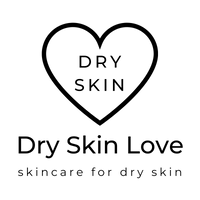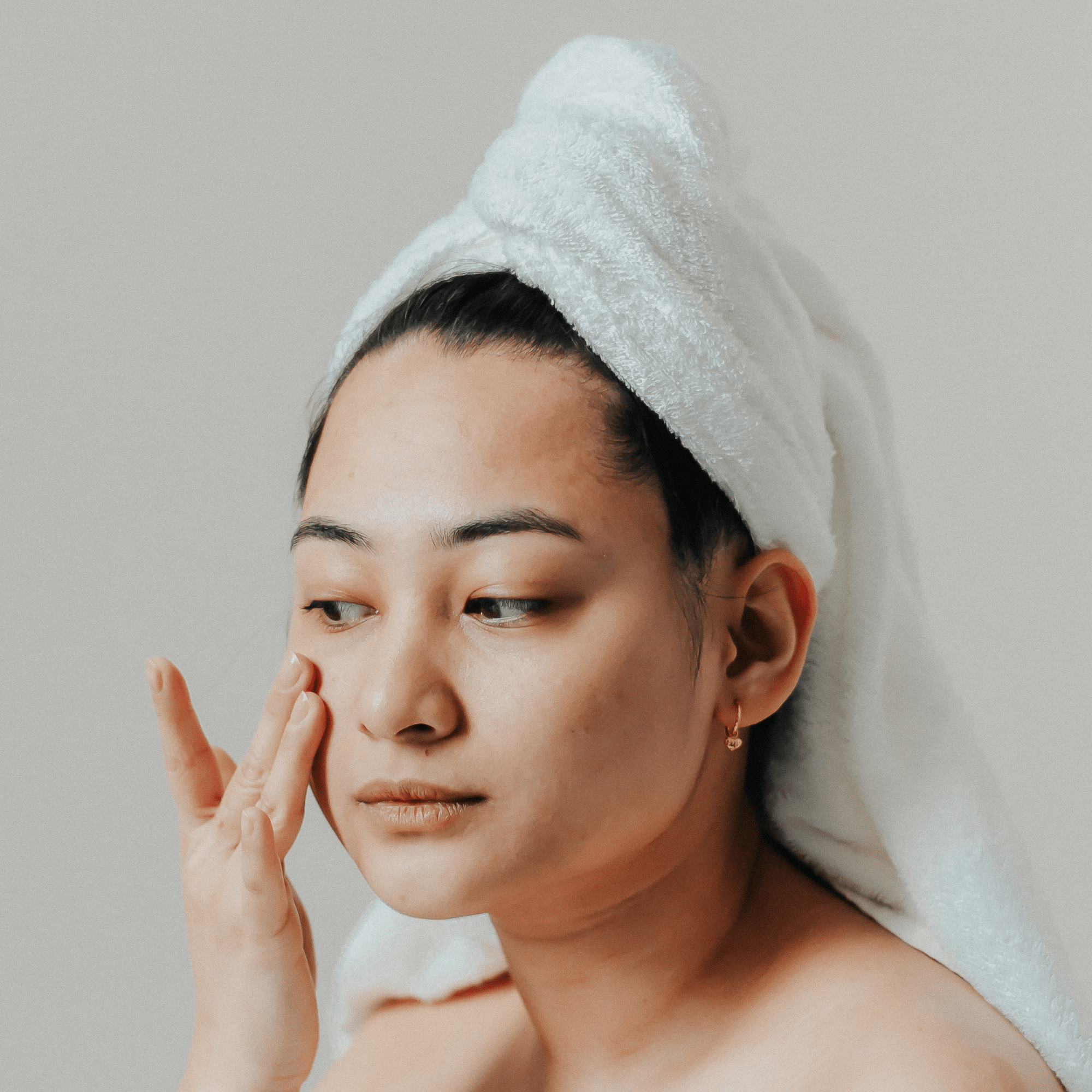Treating dry flaky skin is a multi-step process that involves changing the way you wash, exfoliate, moisturize and care for your skin every day.
Following a dry skin-friendly routine will clear up your dry skin and help it look bright, healthy and smooth once more.
This article will discuss:
- What is dry flaky skin?
- What causes dry flaky skin?
- How to treat flaky skin?
- Cleanse dry flaky skin
- Exfoliate dry flaky skin
- Moisturize dry flaky skin
- Protect dry flaky skin
- Summary
- References

What is dry flaky skin?
Dry skin appears dry, rough, and may scale and flake.
Dry flaky skin is lacking water, humectants and fats.
Humectants absorb and hold water, while fats coat the skin and seal in moisture.
When there is not enough water, humectants or fats, skin barrier disruption can occur, further worsening symptoms of dry skin, including flakiness.
The following contribute to dry skin:
- lack of water in skin
- lack of water-holding substances called humectants (glycerin, hyaluronic acid, natural moisturizing factors)
- lack of epidermal lipids (ceramides, fatty acids, cholesterol)
- lack of sebum (triglycerides, wax esters, squalene)
Symptoms of dry skin include:
- Loss of skin elasticity.
- Skin feels tight, dehydrated.
- Skin appears dull, rough and blotchy.
- Slight to severe flaking, scaling or peeling.
- Fine lines and wrinkles are more pronounced.
- May have irritation and a burning sensation.
- May have itching.
Anyone can develop dry skin.
Read more: What is Dry Skin?

What causes dry flaky skin?
Dry skin is very common and can occur for a variety of reasons. You may have naturally dry skin. But even if your skin type is normal or oily, you can still develop dry skin from time to time. Dry skin can affect any part of your body.
Dry skin can be caused or worsened by:
- Exposure to cold weather
- Low humidity levels
- UV radiation and sunlight
- Harsh soaps or detergents
- Swimming in chlorinated pools
- Long and hot showers or baths
- Aging
- Menopause
Read more: What Causes Dry Skin?

How to treat dry flaky skin
Treating dry flaky skin can be frustrating, as it can be difficult to treat.
Dry flaky skin is often relieved with the use of moisturizers, emollients, and some lifestyle modifications, such as using a humidifier, avoiding harsh cleansers, and supplementing the diet with essential fatty acids.
In addition, nutrient-rich oils, balms and barrier creams are required to improve dry skin and protect against further damage.
Active ingredients, including vitamins, humectants, lipids and fatty acids can help repair the skin barrier, calm redness, and sooth irritation and itch.
Some people with dry flaky skin may also require medications to control symptoms, including antimicrobial agents, antihistamines, anti-inflammatory agents, anesthetics, immunotherapy, biologicals, and others.
Treating dry flaky skin includes the following basic steps:
- Cleanse
- Exfoliate
- Moisturize
- Protect
Talk to your doctor about treatments for dry flaky skin.

1. Cleanse dry flaky skin
Cleansing your skin is essential to keeping your skin healthy.
The main purpose of skin cleansing is to remove impurities from the skin’s surface, including makeup, dirt, grime, and daily skin debris.
There are many different types of face cleansers that are beneficial for dry flaky skin.
For daily cleansing, there are many options, including syndets, cold creams, cleansing milks, cleansing oils, cleansing balms, micellar water and non-foaming cleansers.
For removing heavy make-up and sunscreens, cleansing balms and cleansing oils are the best choice.
Soaps and cleansers that are high in pH should be avoided, as high pH soaps can be irritating and disrupt the skin barrier.
Learn more: 8 Types of Face Cleansers - Which Are Best for Cleansing Dry Skin?

2. Exfoliate dry flaky skin
Exfoliating is the process of removing dead skin cells from the surface of your skin using a chemical, granular substance, or exfoliation tool. Your skin naturally sheds dead skin cells; however, sometimes dead cells don’t shed completely.
A buildup of dead skin cells can lead to the visible appearance of dryness, roughness, scaling, and flaking.
'Oil exfoliation' is a method of using oil and a warm moist cloth to exfoliate your skin.
Oil is generously applied to your skin and massaged and then allowed to sit for up to an hour. As the oil sinks into your skin, it gently loosens the dead skin cells on the surface.
A warm moist cloth is then gently massaged over your oiled skin, and the water and cloth help to remove the oil and dead skin cells.
The cloth also serves as a manual exfoliant, as it helps to physically scrape and remove surface skin cells.
The oil helps to protect your skin against any abrasiveness from the cloth.
Oil exfoliation can gently remove dry flaky skin on your face and leave your skin feeling clean, soft and smooth.
Oil exfoliation can remove flaky skin fast! Without damaging your skin.
Oil exfoliation is very gentle on your skin and protects your skin barrier.
Learn more: How To Treat Dry Flaky Skin on Face - Oil Exfoliation

3. Moisturize dry flaky skin
A moisturizer is a skincare product, such as a cream or a lotion, that is used to prevent dryness in the skin.
Moisturizers contain water and add moisture to the skin.
Moisturizers also contain emollients, humectants and occlusives.
- Emollients soften, smooth, and condition the skin.
- Humectants attract and hold moisture to the skin.
- Occlusives form a protective film that prevents moisture loss from the skin.
The balance of these ingredients determines whether a moisturizer is better for dry skin or oily skin. For instance, a moisturizer for dry skin would contain a high percentage of emollients and occlusives.
As the composition of moisturizers varies, the effectiveness of moisturizers can differ depending on the base ingredients and actives.
Learn more: What Are Emollients? Best Emollients for Dry Skin

4. Protect dry flaky skin
Dry flaky skin must be protected from the external elements.
During the daytime, dry skin can be protected by using sunscreen and sunblock to protect against UV damage and sunlight.
Protective clothing, including face covering, sunglasses and gloves can also be worn to protect against cold, wind and UV damage.
Dry skin can also be protected by using an occlusive.
Occlusives are skincare ingredients or products that form a protective film that prevents moisture loss from the skin.
They are usually oily or waxy.
Occlusives include:
- Mineral oil
- Petrolatum
- Lanolin - from sheep's wool
- Beeswax
- Cocoa Butter
- Jojoba oil - mild occlusive properties due to its waxy nature
Mineral oil and petrolatum are two of the most effective occlusive ingredients.
"Slugging" is a viral beauty trend that entails slathering a petrolatum-based ointment on your skin. Slugging leaves your skin feeling moisturized and plump.
Petrolatum creates an occlusive layer and keeps water locked in your skin overnight.
Some ingredients that are emollients also have occlusive properties.
For instance, cocoa butter is an emollient because it softens skin, and cocoa butter is also an occlusive because it forms protective barrier on your skin.
Cocoa butter is rich in nutrients and feels very nourishing on dry skin.
However, avoid using cocoa butter for prolonged periods on your face, as it can clog pores and aggravate acne in some individuals.
Jojoba oil is a unique oil that is made of liquid wax esters that are similar to the natural esters produced by the sebaceous glands in your skin.
Jojoba oil is highly emollient, non-greasy and quickly absorbed, leaving your skin with a silky feel.
Dry Skin Love Apple Elixir 5% Vitamin E Face Oil contains cold-pressed organic golden jojoba seed oil.
Summary
Treating dry flaky skin is a multi-step process that involves changing the way you cleanse, exfoliate, moisturize and care for your skin every day.
There are many different types of face cleansers that are beneficial for dry flaky skin including syndets, cold creams, cleansing milks, cleansing oils, cleansing balms, micellar water and non-foaming cleansers.
Soaps and cleansers that are high in pH should be avoided, as high pH soaps can be irritating and disrupt the skin barrier.
Exfoliating is the process of removing dead skin cells from the surface of your skin. Oil exfoliation can gently remove dry flaky skin on your face and leave your skin feeling clean, soft and smooth.
For moisturization, choose a moisturizer that contains emollients, humectants and occlusives.
Dry flaky skin must be protected from the external elements.
During the daytime, dry skin can be protected by using sunscreen and sunblock to protect against UV damage and sunlight.
Dry skin can also be protected by using an occlusive to form a protective film that prevents moisture loss from the skin.
Following a dry skin-friendly routine will clear up your dry skin and help it look bright, healthy and smooth once more.
Author Information

Dr. Natasha Ryz is the founder of Dry Skin Love Skincare. With over 10 years of experience as a formulator and a strong scientific foundation, Dr. Ryz creates products that combine the best of nature and science for transformative results.
She trained in Organic Skincare Formulation at Formula Botanica and took the Skincare Specialist Program at the School of Natural Skincare, with over 200 hours of specialized education. Dr. Ryz also holds a diploma in Beauty Brand Business Management.
Dr. Ryz’s scientific background includes a PhD in Experimental Medicine from the University of British Columbia, and she has over 15 years of research experience in microbiology, immunology, and biochemistry. This expertise informs every product she formulates, ensuring exceptional quality, efficacy, and luxury.
Why I Started A Skincare Company

